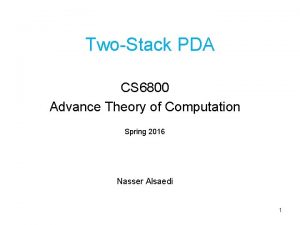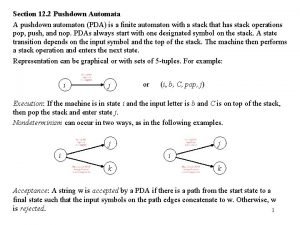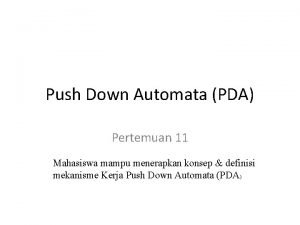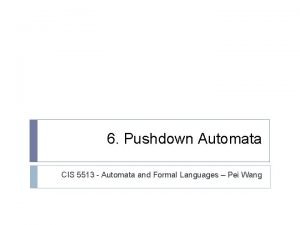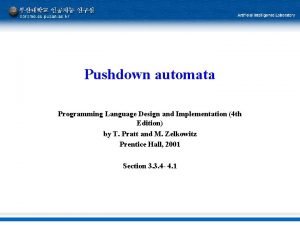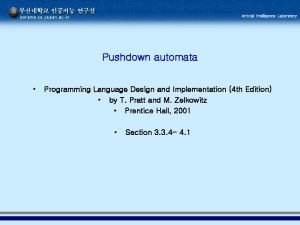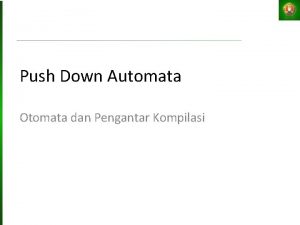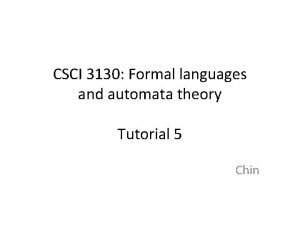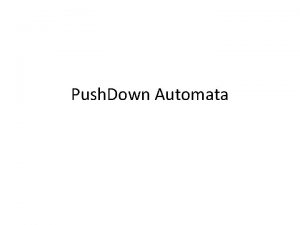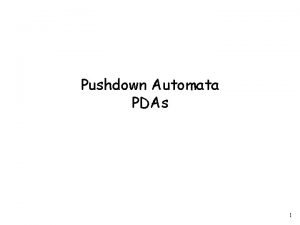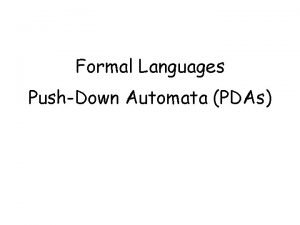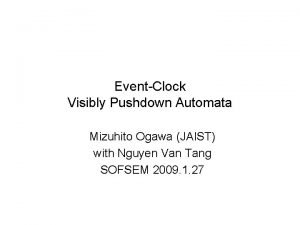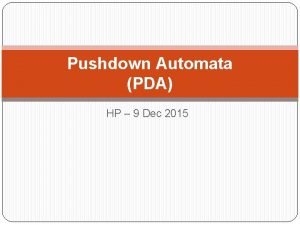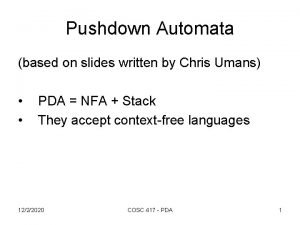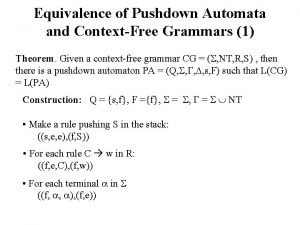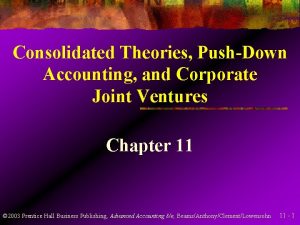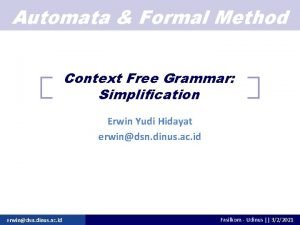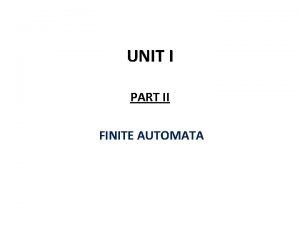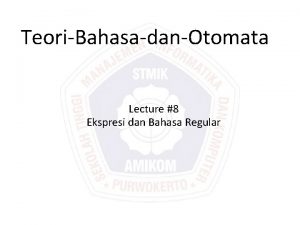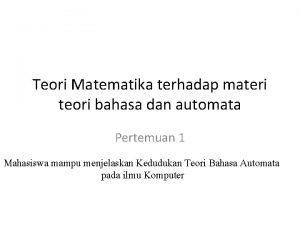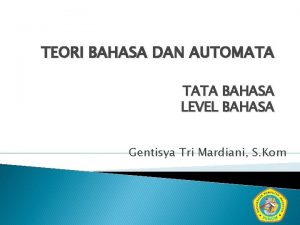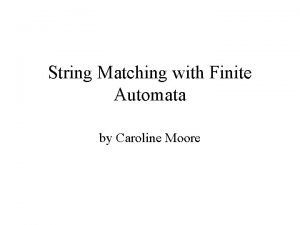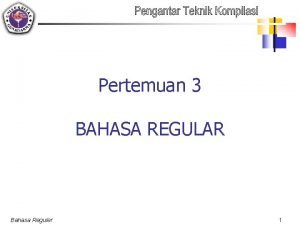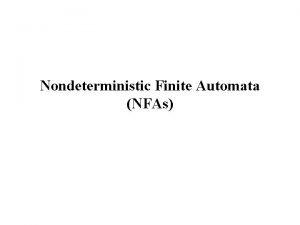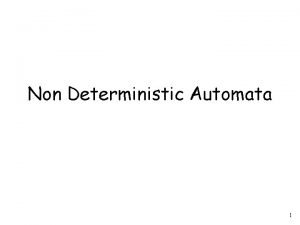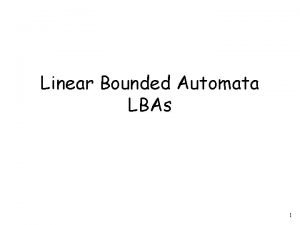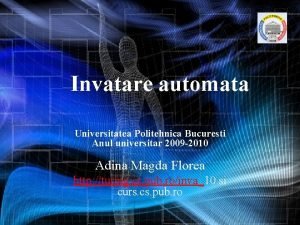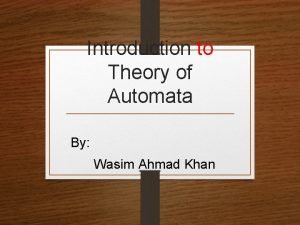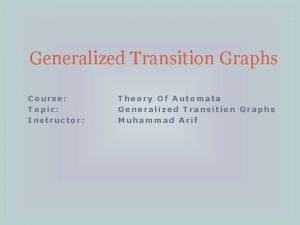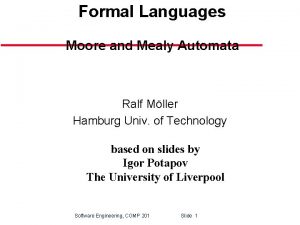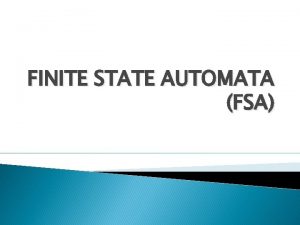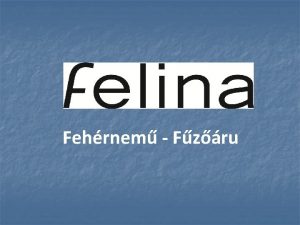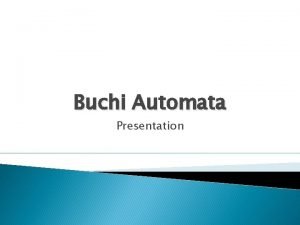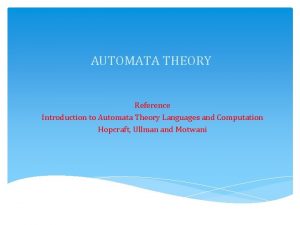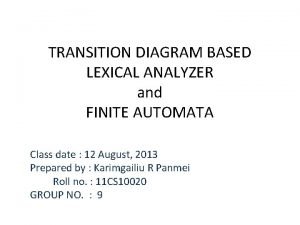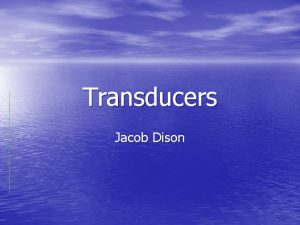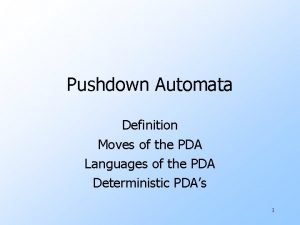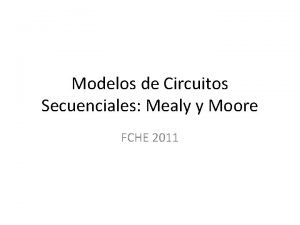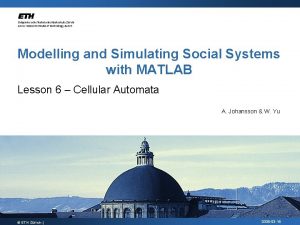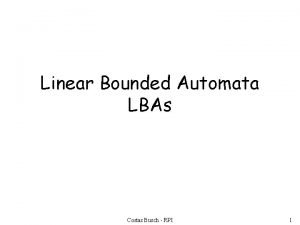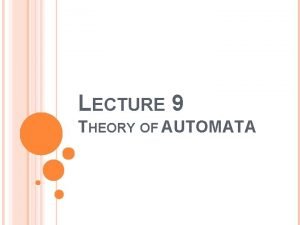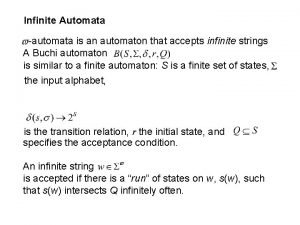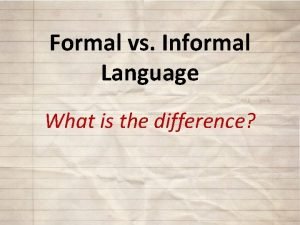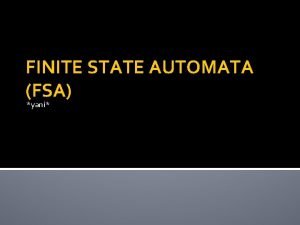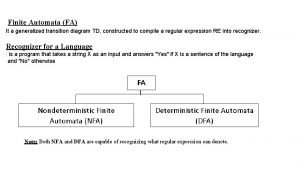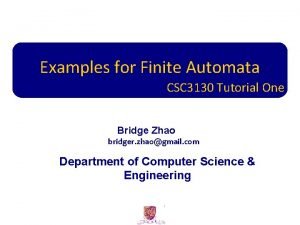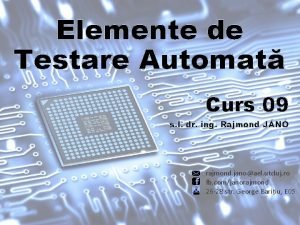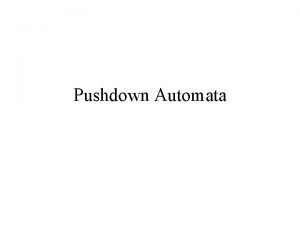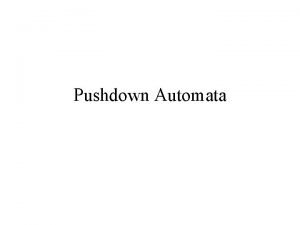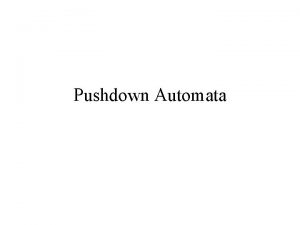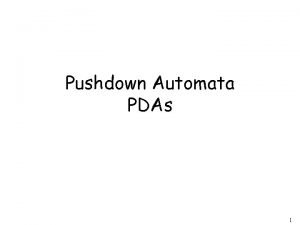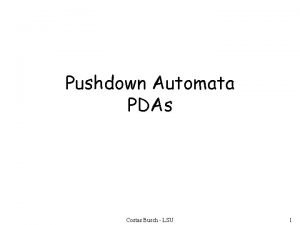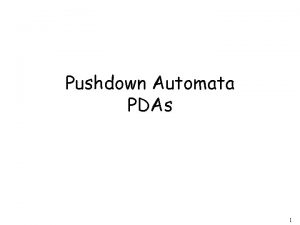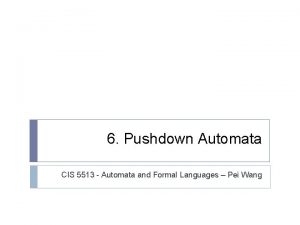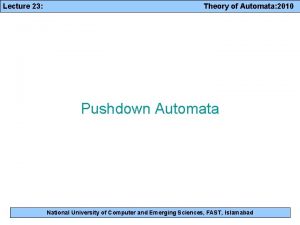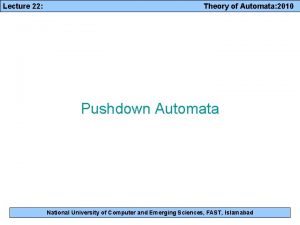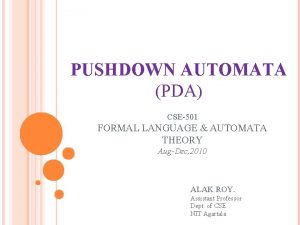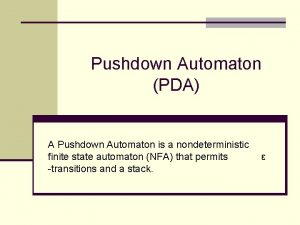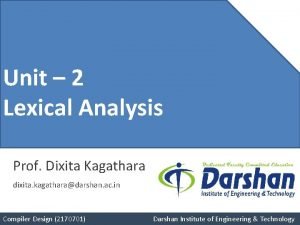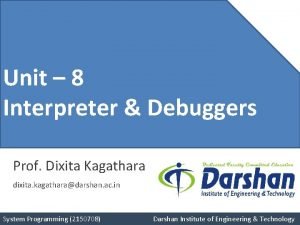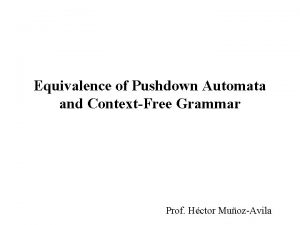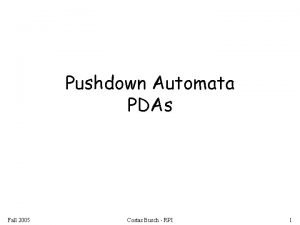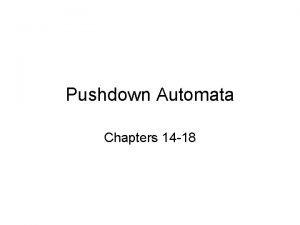Unit 4 Unit 7 Pushdown Compiler Automata Prof





















































![Available expression § B 1: t 1=4*i B 2: t 2: c+d[t 1] B Available expression § B 1: t 1=4*i B 2: t 2: c+d[t 1] B](https://slidetodoc.com/presentation_image/3a7fc97e0230b0c5c427e50cc70275a7/image-54.jpg)


- Slides: 56

Unit – 4 Unit – 7 Pushdown Compiler Automata Prof. Dixita Kagathara dixita. kagathara@darshan. ac. in System Programming (2150708) Unit – 7 : Compiler Darshan Institute of Engineering & Technology

Topics to be covered • Causes of large semantic gap • Binding and binding times • Data structure used in compiling • Scope rules • Memory allocation • Compilation of expression • Compilation of control structure • Code optimization Unit – 7 : Compiler System Programming (2150708) 2 Darshan Institute of Engineering & Technology

Causes of large semantic gap Two aspects of compilation are: 1. Generate code to implement meaning of a source program in the execution domain. (target code generation) 2. Provide diagnostics for violations of programming language semantics in a program. (Error reporting) • There are four issues involved in implementing these aspects: 1. Data types 2. Data structures 3. Scope rules 4. Control structure Unit – 7 : Compiler System Programming (2150708) 3 Darshan Institute of Engineering & Technology

Binding & Binding time • Binding is the association of an attribute of a program entity with a value. • Binding time is the time at which a binding is actually performed. • The following binding times arise in compilers: 1. Language definition time of a programming language L, which is the time at which features of the language are specified. (Example: bind operator symbols to operations) 2. Language implementation time of a programming language L, which is the time at which the design of a language translator for L is finalized. (Example: bind floating point type to a representation) 3. Compilation time of a program P. (Example: bind a variable to a type in C or Java) 4. Execution init time of a procedure proc. (Example: bind a C or C++ static variable to a memory cell) 5. Execution time of a procedure proc. (Example: bind a non static local variable to a memory cell) Unit – 7 : Compiler System Programming (2150708) 4 Darshan Institute of Engineering & Technology

Data structures used in compilers System Programming (2150708) Unit – 7 : Compiler Darshan Institute of Engineering & Technology

Data structures used in compilers • Two types of data structures used in a compiler are: 1. Stack 2. Heap Unit – 7 : Compiler System Programming (2150708) 6 Darshan Institute of Engineering & Technology

Stack • The stack is a linear data structure. • It follows LIFO (Last In First Out) rule. • Each time a procedure is called, space for its local variables is pushed onto a stack, and when the procedure terminates, space is popped off the stack. Unit – 7 : Compiler System Programming (2150708) 7 Darshan Institute of Engineering & Technology

Heap • The heap data structure permits allocation and deallocation of entities in a random order. • Heap is non linear data structure. • When a program makes an allocation request, the heap manager allocates a memory area and returns its address. • The program is expected to save this address in a pointer and use it to access the allotted entity. • When a program makes a deallocation request, the heap manager deallocates a memory area. Unit – 7 : Compiler System Programming (2150708) 8 Darshan Institute of Engineering & Technology

Scope rules System Programming (2150708) Unit – 7 : Compiler Darshan Institute of Engineering & Technology

Scope rules • A block in a program is a function, a procedure, or simply a unit of code that may contain data declaration. • Entities declared in a block must have unique names. • These entities can be accessed only within the block. • Thus, places where an entity can be accessed or visible is referred to the scope of that entity. • There are two types of variable situated in the block structured language: 1. Local variable 2. Non local variable Unit – 7 : Compiler System Programming (2150708) 10 Darshan Institute of Engineering & Technology

Local and nonlocal variables Consider following program: Procedure A { int x, y, z Procedure B A Local variables x, y, z { B a, b Nonlocal variables x, y, z int a, b Procedure } } Unit – 7 : Compiler System Programming (2150708) 11 Darshan Institute of Engineering & Technology

Memory allocation System Programming (2150708) Unit – 7 : Compiler Darshan Institute of Engineering & Technology

Memory allocation • Memory allocation involves three important tasks: 1. Determining the amount of memory required for storing the value of data item. 2. Using an appropriate memory allocation model. 3. Developing appropriate memory mappings for accessing values stored in a data structure. • Types of memory allocations are: 1. Static memory allocation 2. Dynamic memory allocation Unit – 7 : Compiler System Programming (2150708) 13 Darshan Institute of Engineering & Technology

Static memory allocation • In static memory allocation, memory is allocated to a variable before the execution of a program begins. • No memory allocation or deallocation actions are performed during the execution of a program. Thus, variables remain permanently allocated. Code(A) Data(A) Code(B) Data(B) Code(C) Data(C) Unit – 7 : Compiler System Programming (2150708) 14 Darshan Institute of Engineering & Technology

Dynamic memory allocation • In dynamic memory allocation, memory bindings are established and destroyed during the execution of a program. Code(A) Code(B) Code(C) Data(A) Data(C) Data(B) Unit – 7 : Compiler System Programming (2150708) 15 Darshan Institute of Engineering & Technology

Dynamic memory allocation • Types of dynamic memory allocation are: 1. Automatic allocation: memory is allocated to the variables declared in a procedure when the procedure is entered during execution and is deallocated when the procedure is exited. 2. Program controlled allocation: a program can allocate or deallocate memory at any time during its execution. Unit – 7 : Compiler System Programming (2150708) 16 Darshan Institute of Engineering & Technology

Dynamic memory allocation and access • Each record in a stack is used to accommodate variables of one activation of a block, is called activation record. Used for memory allocation and deallocation. 0 (ARB): Dynamic pointer ARB (activation record base) 1 (ARB): static pointer Reserved pointer Used for accessing nonlocal variables. TOS Stack record format Unit – 7 : Compiler System Programming (2150708) 17 Darshan Institute of Engineering & Technology

Memory allocation in block structured language • The block is a sequence of statements containing the local data and declarations which are enclosed within the delimiters. A { Statements …. . } • A block structured language uses dynamic memory allocation. • Finding the scope of the variable means checking the visibility within the block. • Following are the rules used to determine the scope of the variable: 1. Variable X is accessed within the block B 1 if it can be accessed by any statement situated in block B 1. 2. Variable X is accessed by any statement in block B 2 if block B 2 is situated inside block B 1. Unit – 7 : Compiler System Programming (2150708) 18 Darshan Institute of Engineering & Technology

Compilation of expressions System Programming (2150708) Unit – 7 : Compiler Darshan Institute of Engineering & Technology

Compilation of expressions • The major issues in code generation for expressions are as follows: 1. Determination of an evaluation order for the operators in an expression. 2. Selection of instruction to be used in target code. 3. Use of registers. Unit – 7 : Compiler System Programming (2150708) 20 Darshan Institute of Engineering & Technology

A toy code generator for expressions • A toy code generator has to track both the registers (for availability) and addresses (location of values) while generating the code. • For both of them, the following two descriptors are used: • The code generator uses the notation of an operand descriptor to maintain type, length and addressability information for each operand. • It uses a register descriptor to maintain information about what operand or partial result would be contained in a CPU register during execution of the generated code. Unit – 7 : Compiler System Programming (2150708) 21 Darshan Institute of Engineering & Technology

Operand descriptors • An operand descriptor has the following fields: 1. Attributes: Contains the subfields type, and length. 2. Addressability: Specifies where the operand is located, and how it can be accessed. It has two subfields: I. Addressability code: Takes the values 'M' (operand is in memory), and 'R' (operand is in register). II. Address: Address of a CPU register or memory word. • Example: a*b MOVER AREG, A MULT AREG, B Unit – 7 : Compiler System Programming (2150708) Attribute (int, 1) 22 Addressability M, Address(a) M, Address(b) R, Address(AREG) Operand_descriptor[1] Operand_descriptor[2] Operand_descriptor[3] Darshan Institute of Engineering & Technology

Register descriptors • A register descriptor has two fields: 1. Status: Contains the code free or occupied to indicate register status. 2. Operand descriptor: If status = occupied, this field contains the descriptor for the operand contained in the register. • The register descriptor for AREG after generating code for a*b would be: Status Operand descriptor # Occupied #3 • This indicates that register AREG contains the operand described by descriptor #3. Unit – 7 : Compiler System Programming (2150708) 23 Darshan Institute of Engineering & Technology

Intermediate codes for expressions System Programming (2150708) Unit – 7 : Compiler Darshan Institute of Engineering & Technology

Types of intermediate forms • Types of intermediate forms: 1. Expression tree 2. Postfix notation 3. Three address code Unit – 7 : Compiler System Programming (2150708) 25 Darshan Institute of Engineering & Technology

Expression tree • A expression tree depicts the natural hierarchical structure of a source program. • Ex: a=b*-c+b*-c = + * * b uminus c c Unit – 7 : Compiler System Programming (2150708) a 26 Darshan Institute of Engineering & Technology

Postfix notation • Postfix notation is a linearization of a syntax tree. • In postfix notation the operands occurs first and then operators are arranged. • Example: 9 -5+2 = 95 -2+ Unit – 7 : Compiler System Programming (2150708) 27 Darshan Institute of Engineering & Technology

Three address code • Three address code is a sequence of statements of the general form, a: = b op c • Where a, b or c are the operands that can be names or constants and op stands for any operator. • Example: a = b + c + d t 1=b+c t 2=t 1+d a= t 2 • Here t 1 and t 2 are the temporary names generated by the compiler. • There at most three addresses allowed (two for operands and one for result). Hence, this representation is called three-address code. Unit – 7 : Compiler System Programming (2150708) 28 Darshan Institute of Engineering & Technology

Different representation of three address code System Programming (2150708) Unit – 7 : Compiler Darshan Institute of Engineering & Technology

Different representation of three address code • There are three types of representation used for three address code: 1. Quadruples 2. Triples 3. Indirect triples • Ex: x= -a*b + -a*b t 1= - a t 2 = t 1 * b t 3= - a t 4 = t 3 * b Three Address Code t 5 = t 2 + t 4 x= t 5 Unit – 7 : Compiler System Programming (2150708) 30 Darshan Institute of Engineering & Technology

Quadruple • The quadruple is a structure with at the most four fields such as op, arg 1, arg 2 and result. • The op field is used to represent the internal code for operator. • The arg 1 and arg 2 represent the two operands. • And result field is used to store the result of an expression. Quadruple x= -a*b + -a*b t 1= - a t 2 = t 1 * b t 3= - a t 4 = t 3 * b t 5 = t 2 + t 4 x= t 5 Unit – 7 : Compiler System Programming (2150708) No. Operator Arg 1 (0) uminus a (1) * t 1 (2) uminus a (3) * t 3 b t 4 (4) + t 2 t 4 t 5 (5) = t 5 31 Arg 2 Result t 1 b t 2 t 3 x Darshan Institute of Engineering & Technology

Triple • To avoid entering temporary names into the symbol table, we might refer a temporary value by the position of the statement that computes it. • If we do so, three address statements can be represented by records with only three fields: op, arg 1 and arg 2. Triple Quadruple Arg 2 Result No. Operator Arg 1 t 1 (0) uminus a (1) * (0) (2) uminus a (3) * (2) b t 5 (4) + (1) (3) x (5) = x (4) No. Operator Arg 1 (0) uminus a (1) * t 1 (2) uminus a (3) * t 3 b t 4 (4) + t 2 t 4 (5) = t 5 b t 2 t 3 Unit – 7 : Compiler System Programming (2150708) 32 Arg 2 b Darshan Institute of Engineering & Technology

Indirect triple • In the indirect triple representation the listing of triples has been done. And listing pointers are used instead of using statement. • This implementation is called indirect triples. Triple Indirect Triple Statement No. Operator Arg 1 (0) (14) (0) uminus a (1) (15) (1) * (14) (2) (16) (2) uminus a b (3) (17) (3) * (16) b (1) (3) (4) (18) (4) + (15) (17) x (4) (5) (19) (5) = x (18) No. Operator Arg 1 (0) uminus a (1) * (0) (2) uminus a (3) * (2) (4) + (5) = Arg 2 b Unit – 7 : Compiler System Programming (2150708) 33 Arg 2 b Darshan Institute of Engineering & Technology

Exercise Write quadruple, triple and indirect triple for following statements: 1. -(a*b)+(c+d) 2. a*-(b+c) 3. x=(a+b*c)^(d*e)+f*g^h 4. g+a*(b-c)+(x-y)*d Unit – 7 : Compiler System Programming (2150708) 34 Darshan Institute of Engineering & Technology

Compilation of control structures System Programming (2150708) Unit – 7 : Compiler Darshan Institute of Engineering & Technology

Parameter passing mechanisms • Types of parameter passing methods are: 1. Call by value 2. Call by result 3. Call by reference 4. Call by name Unit – 7 : Compiler System Programming (2150708) 36 Darshan Institute of Engineering & Technology

Call by value • This is the simplest method of parameter passing. • The call by value method of passing arguments to a function copies the actual value of an argument into the formal parameter of the function. • The operations on formal parameters do not change the values of a parameter. Unit – 7 : Compiler System Programming (2150708) 37 Darshan Institute of Engineering & Technology

Call by result • It is similar to call by value with one difference. • At the time of return from the called function, the values of formal parameters are copied back into corresponding actual parameter. Unit – 7 : Compiler System Programming (2150708) 38 Darshan Institute of Engineering & Technology

Call by reference • This method is also called as call by address or call by location. • The call by reference method of passing arguments to a function copies the address of an argument into the formal parameter. • Inside the function, the address is used to access the actual argument used in the call. • It means the changes made to the parameter affect the passed argument. Unit – 7 : Compiler System Programming (2150708) 39 Darshan Institute of Engineering & Technology

Call by name • This is less popular method of parameter passing. • Procedure is treated like macro. • The procedure body is substituted for call in caller with actual parameters substituted formals. • The local names of called procedure and names of calling procedure are distinct. Unit – 7 : Compiler System Programming (2150708) 40 Darshan Institute of Engineering & Technology

Code optimization System Programming (2150708) Unit – 7 : Compiler Darshan Institute of Engineering & Technology

Optimization & types of optimization • Code optimization aims at improving the execution efficiency of a program. • This achieved in two ways: 1. Redundancies in a program are eliminated. 2. Computations in a program are rearranged or rewritten to make it execute efficiently. • There are two types of optimization: • Local optimization: the optimizing transformation are applied over small segments of a program consisting of a few statements. • Global optimization: the optimizing transformation are applied over program unit, i. e. over a function or a procedure. Unit – 7 : Compiler System Programming (2150708) 42 Darshan Institute of Engineering & Technology

Compile time evaluation • Compile time evaluation means shifting of computations from run time to compile time. Constant folding • In this technique the value of variable is replaced and computation of an expression is done at compilation time. • Example: pi = 3. 14; r = 5; Area = pi * r; • Here at the compilation time the value of pi is replaced by 3. 14 and r by 5 then computation of 3. 14 * 5 is done during compilation. Unit – 7 : Compiler System Programming (2150708) 43 Darshan Institute of Engineering & Technology

Common sub expressions elimination • The common sub expression is an expression appearing repeatedly in the program which is computed previously. • If the operands of this sub expression do not get changed at all then result of such sub expression is used instead of re-computing it each time. • Example: t 1 : = 4 * i t 2 : = a[t 1] t 3 : = 4 * j t 4 : = 4 * i t 5: = n t 6 : = b[t 4]+t 5 t 6 : = b[t 1]+t 5 Unit – 7 : Compiler System Programming (2150708) 44 Darshan Institute of Engineering & Technology

Frequency reduction • Optimization can be obtained by moving some amount of code outside the loop and placing it just before entering in the loop. • This method is also called loop invariant computation. • Example: While(i<=max-1) { sum=sum+a[i]; } Unit – 7 : Compiler System Programming (2150708) N=max-1; While(i<=N) { sum=sum+a[i]; } 45 Darshan Institute of Engineering & Technology

Strength reduction • Precedence of certain operators is higher than others. • For instance strength of * is higher than +. • In this technique the higher strength operators can be replaced by lower strength operators. • Example: for(i=1; i<=50; i++) temp=7; { } for(i=1; i<=50; i++) { count = temp; temp = temp+7; } count = i*7; • Here we get the count values as 7, 14, 21…. and so on. Unit – 7 : Compiler System Programming (2150708) 46 Darshan Institute of Engineering & Technology

Dead code elimination • The variable is said to be dead at a point in a program if the value contained into it is never been used. • The code containing such a variable supposed to be a dead code. • Example: i=0; if(i==1) { Dead Code a=x+5; } • If statement is a dead code as this condition will never get satisfied hence, statement can be eliminated and optimization can be done. Unit – 7 : Compiler System Programming (2150708) 47 Darshan Institute of Engineering & Technology

Control & Dataflow Analysis System Programming (2150708) Unit – 7 : Compiler Darshan Institute of Engineering & Technology

Control flow analysis • Control flow analysis analyses a program to collect information concerning its structure. • The control flow concept of interest are: 1. Predecessors & Successors 2. Paths 3. Ancestors & Descendants 4. Dominators Unit – 7 : Compiler System Programming (2150708) 49 Darshan Institute of Engineering & Technology

Predecessors & Successors Predecessor of B 2 Successor of B 1 y=2 B 1 y=y+2 B 2 • Basic block B 1 is a predecessor of B 2. • Basic block B 2 is a successor of B 1. Unit – 7 : Compiler System Programming (2150708) 50 Darshan Institute of Engineering & Technology

Path & Ancestors, Descendants y=2 B 1 Ancestors of B 2 y=y+2 B 2 Descendants of B 1 Path • A path is a sequence of edges such that the destination node of one edge is the source node of the following edge. • If path exists from B 1 to B 2, B 1 is an Ancestors of B 2 and B 2 is Descendants of B 1. Unit – 7 : Compiler System Programming (2150708) 51 Darshan Institute of Engineering & Technology

Dominators • In a flow graph, a node d dominates n if every path to node n from initial node goes through d only. This can be denoted as ’d dom n'. • Every initial node dominates all the remaining nodes in the flow graph. • Every node dominates itself. 1 2 3 4 5 • Node 1 is initial node and it dominates every node as it is initial node. • Node 2 dominates 3, 4 and 5. Unit – 7 : Compiler System Programming (2150708) 52 Darshan Institute of Engineering & Technology

Dataflow analysis • Dataflow property represent the certain information regarding usefulness of data items for the purpose of optimization. • The data flow properties are: 1. Available expression 2. Live variable Unit – 7 : Compiler System Programming (2150708) 53 Darshan Institute of Engineering & Technology
![Available expression B 1 t 14i B 2 t 2 cdt 1 B Available expression § B 1: t 1=4*i B 2: t 2: c+d[t 1] B](https://slidetodoc.com/presentation_image/3a7fc97e0230b0c5c427e50cc70275a7/image-54.jpg)
Available expression § B 1: t 1=4*i B 2: t 2: c+d[t 1] B 3: t 3=4*i B 4: t 4=a[t 3] Unit – 7 : Compiler System Programming (2150708) 54 Darshan Institute of Engineering & Technology

Live variable § Unit – 7 : Compiler System Programming (2150708) 55 Darshan Institute of Engineering & Technology

End of Unit - 7 System Programming (2150708) Unit – 7 : Compiler Darshan Institute of Engineering & Technology
 Two stack pda
Two stack pda Pushdown automata examples
Pushdown automata examples Makalah push down automata
Makalah push down automata Pushdown automata exercises
Pushdown automata exercises Pushdown automata implementation
Pushdown automata implementation Pushdown automata implementation
Pushdown automata implementation Pda examples
Pda examples Pushdown automata
Pushdown automata Push down automata
Push down automata Pda
Pda Languages accepted by pda
Languages accepted by pda Automata
Automata Pushdown automata
Pushdown automata Pushdown automata
Pushdown automata Pushdown automata
Pushdown automata Lex yacc example
Lex yacc example Cross compiler in compiler design
Cross compiler in compiler design Pushdown accounting
Pushdown accounting Unit production in automata
Unit production in automata Unit 10, unit 10 review tests, unit 10 general test
Unit 10, unit 10 review tests, unit 10 general test Informal language definition
Informal language definition Deterministic finite automaton
Deterministic finite automaton Notasi ekspresi reguler
Notasi ekspresi reguler Bahasa automata
Bahasa automata Contoh soal dan jawaban aturan produksi fsa
Contoh soal dan jawaban aturan produksi fsa Sebutkan level 0 dari fsa (natural language)
Sebutkan level 0 dari fsa (natural language) String matching finite automata
String matching finite automata Recursive language in automata
Recursive language in automata Notasi ekspresi regular
Notasi ekspresi regular Finite automation
Finite automation Nfa to dfa
Nfa to dfa Linear bounded automata example
Linear bounded automata example Invatare automata
Invatare automata What is the concept of valid and invalid alphabets
What is the concept of valid and invalid alphabets Generalized transition graph in automata examples
Generalized transition graph in automata examples Mealy model
Mealy model Npda automata
Npda automata Simple grammar automata
Simple grammar automata Contoh fsa
Contoh fsa Felina international ag
Felina international ag Automata etimologia
Automata etimologia Central concepts of automata theory in flat
Central concepts of automata theory in flat Lexical analysis finite automata
Lexical analysis finite automata Dfa diagram generator
Dfa diagram generator Bidirectional transducers in automata theory
Bidirectional transducers in automata theory Instantaneous description of pda
Instantaneous description of pda Contoh soal regular expression
Contoh soal regular expression Automata mealy
Automata mealy Cellular automata matlab
Cellular automata matlab Linear bounded automata solved examples
Linear bounded automata solved examples Kleene's theorem
Kleene's theorem Temporal logic
Temporal logic Informal language characteristics
Informal language characteristics Fsa dinyatakan dalam 5 tupel, kecuali
Fsa dinyatakan dalam 5 tupel, kecuali Transition graph to regular expression examples
Transition graph to regular expression examples Automata
Automata Testare automata
Testare automata
